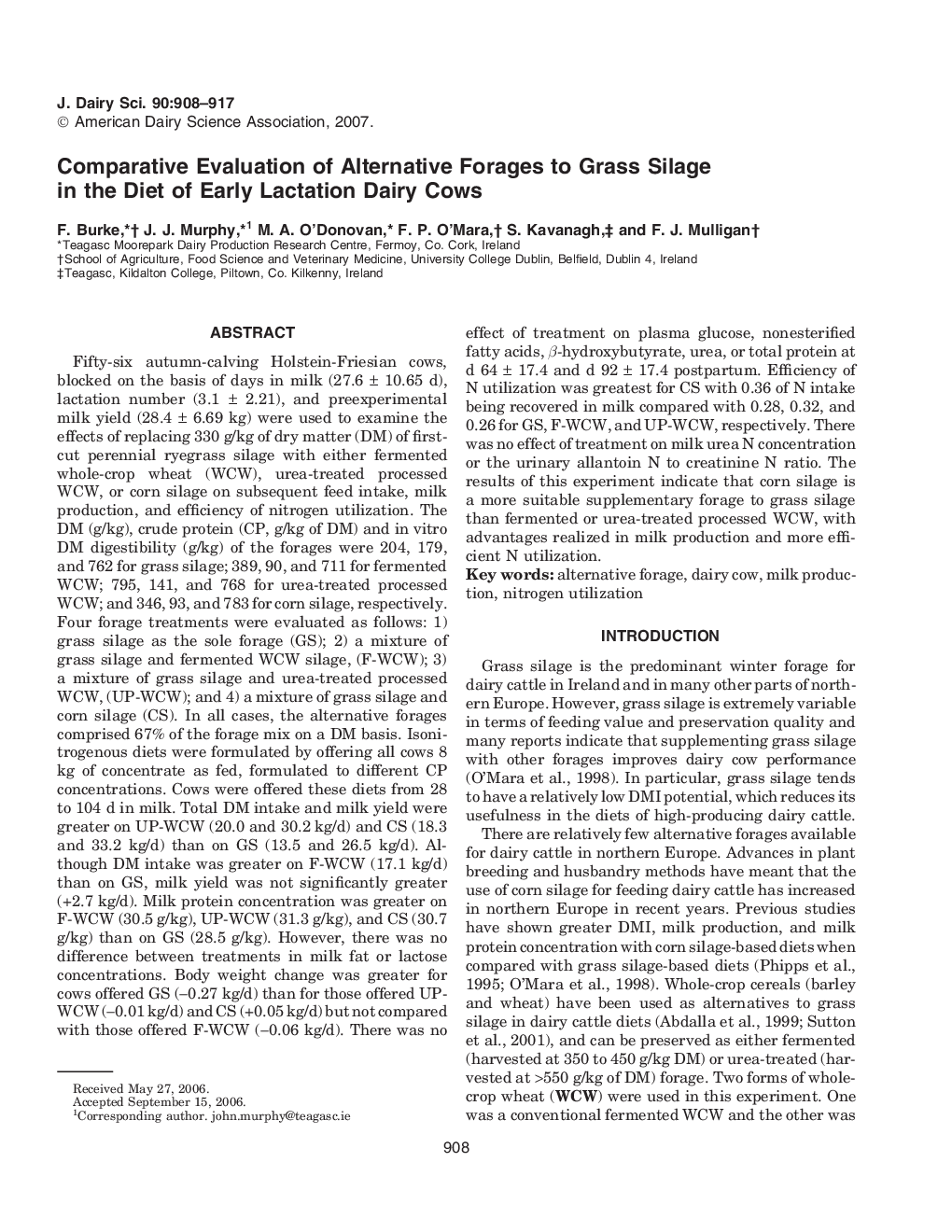| کد مقاله | کد نشریه | سال انتشار | مقاله انگلیسی | نسخه تمام متن |
|---|---|---|---|---|
| 2440356 | 1108116 | 2007 | 10 صفحه PDF | دانلود رایگان |
عنوان انگلیسی مقاله ISI
Comparative Evaluation of Alternative Forages to Grass Silage in the Diet of Early Lactation Dairy Cows
دانلود مقاله + سفارش ترجمه
دانلود مقاله ISI انگلیسی
رایگان برای ایرانیان
کلمات کلیدی
موضوعات مرتبط
علوم زیستی و بیوفناوری
علوم کشاورزی و بیولوژیک
علوم دامی و جانورشناسی
پیش نمایش صفحه اول مقاله

چکیده انگلیسی
Fifty-six autumn-calving Holstein-Friesian cows, blocked on the basis of days in milk (27.6 ± 10.65 d), lactation number (3.1 ± 2.21), and preexperimental milk yield (28.4 ± 6.69 kg) were used to examine the effects of replacing 330 g/kg of dry matter (DM) of first-cut perennial ryegrass silage with either fermented whole-crop wheat (WCW), urea-treated processed WCW, or corn silage on subsequent feed intake, milk production, and efficiency of nitrogen utilization. The DM (g/kg), crude protein (CP, g/kg of DM) and in vitro DM digestibility (g/kg) of the forages were 204, 179, and 762 for grass silage; 389, 90, and 711 for fermented WCW; 795, 141, and 768 for urea-treated processed WCW; and 346, 93, and 783 for corn silage, respectively. Four forage treatments were evaluated as follows: 1) grass silage as the sole forage (GS); 2) a mixture of grass silage and fermented WCW silage, (F-WCW); 3) a mixture of grass silage and urea-treated processed WCW, (UP-WCW); and 4) a mixture of grass silage and corn silage (CS). In all cases, the alternative forages comprised 67% of the forage mix on a DM basis. Isonitrogenous diets were formulated by offering all cows 8 kg of concentrate as fed, formulated to different CP concentrations. Cows were offered these diets from 28 to 104 d in milk. Total DM intake and milk yield were greater on UP-WCW (20.0 and 30.2 kg/d) and CS (18.3 and 33.2 kg/d) than on GS (13.5 and 26.5 kg/d). Although DM intake was greater on F-WCW (17.1 kg/d) than on GS, milk yield was not significantly greater (+2.7 kg/d). Milk protein concentration was greater on F-WCW (30.5 g/kg), UP-WCW (31.3 g/kg), and CS (30.7 g/kg) than on GS (28.5 g/kg). However, there was no difference between treatments in milk fat or lactose concentrations. Body weight change was greater for cows offered GS (â0.27 kg/d) than for those offered UP-WCW (â0.01 kg/d) and CS (+0.05 kg/d) but not compared with those offered F-WCW (â0.06 kg/d). There was no effect of treatment on plasma glucose, nonesterified fatty acids, β-hydroxybutyrate, urea, or total protein at d 64 ± 17.4 and d 92 ± 17.4 postpartum. Efficiency of N utilization was greatest for CS with 0.36 of N intake being recovered in milk compared with 0.28, 0.32, and 0.26 for GS, F-WCW, and UP-WCW, respectively. There was no effect of treatment on milk urea N concentration or the urinary allantoin N to creatinine N ratio. The results of this experiment indicate that corn silage is a more suitable supplementary forage to grass silage than fermented or urea-treated processed WCW, with advantages realized in milk production and more efficient N utilization.
ناشر
Database: Elsevier - ScienceDirect (ساینس دایرکت)
Journal: Journal of Dairy Science - Volume 90, Issue 2, February 2007, Pages 908-917
Journal: Journal of Dairy Science - Volume 90, Issue 2, February 2007, Pages 908-917
نویسندگان
F. Burke, J.J. Murphy, M.A. O'Donovan, F.P. O'Mara, S. Kavanagh, F.J. Mulligan,